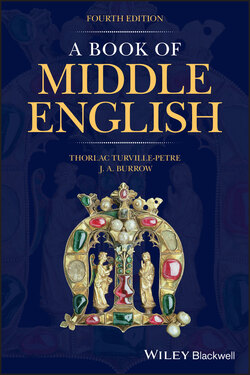Читать книгу A Book of Middle English - J. A. Burrow - Страница 23
2.3 Consonants
ОглавлениеWe have already seen how, in the post‐medieval period, the spelling of vowels failed to keep pace with changes in the sounds themselves (2.2.1 above). The spoken language went on changing, but the written or printed language assumed a standardized, and therefore largely unchanging, set of forms. The result, so far as consonants are concerned, is that modern spelling persists in recording sounds which have long since ceased to be pronounced at all. Examples are the initial letters in modern ‘gnaw’, ‘knot’ and ‘wring’; the final letters in ‘damn’ and ‘comb’; and the medial letters of ‘would’ and (in most pronunciations) ‘night’. It can safely be assumed that letters such as these are to be pronounced whenever they occur in medieval spellings. Thus, Middle English gnawen begins with /g/ – as one might, after all, expect.
Middle English scribes, as represented in this book, employed three consonant symbols unfamiliar to the modern reader. These are: ð (known as ‘eth’), þ (‘thorn’), and ʒ (‘yogh’). Of these, the first two both represent what would now be called ‘th sounds’, without distinguishing in either case between the initial sounds of ‘thin’ and ‘this’. ‘Eth’ is the Latin d with a cross‐stroke, hence Ð in its capital form. This went out of fashion earlier than ‘thorn’, a letter borrowed by Anglo‐Saxon scribes from the runic alphabet. In some areas the letter þ became indistinguishable from y: hence the use of y for th in ‘Ye Olde Teashoppe’. This confusion no doubt contributed to the general adoption of the two‐letter spelling th after 1400. ‘Yogh’ (ʒ) is simply the descendant of the Anglo‐Saxon letter‐form for g, which Middle English scribes retained alongside the ancestor of the modern form of g. They tended to use modern g for the stop consonant as in ‘good’, reserving ʒ for other purposes. It corresponds to modern consonantal y in words such as ʒong, ‘young’, and to modern gh in words such as riʒt, ‘right’. In the latter case, ʒ represents sounds heard in Scots ‘licht’ and ‘loch’.
The adoption of th for þ and of gh for ʒ in later Middle English contributed to the establishment of a set of modern two‐letter spellings for single consonant sounds, where h is regularly the second, differentiating letter. Thus: ch, gh, sh, th. This pattern not being yet established in Middle English, ‘child’ may be spelt cild, ‘shall’ may be schal.
